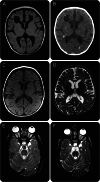Neuroradiologic patterns and novel imaging findings in Aicardi-Goutières syndrome
- PMID: 26581299
- PMCID: PMC4731289
- DOI: 10.1212/WNL.0000000000002228
Neuroradiologic patterns and novel imaging findings in Aicardi-Goutières syndrome
Abstract
Objective: To perform an updated characterization of the neuroradiologic features of Aicardi-Goutières syndrome (AGS).
Methods: The neuroradiologic data of 121 subjects with AGS were collected. The CT and MRI data were analyzed with a systematic approach. Moreover, we evaluated if an association exists between the neuroradiologic findings, clinical features, and genotype.
Results: Brain calcifications were present in 110 subjects (90.9%). Severe calcification was associated with TREX1 mutations and early age at onset. Cerebral atrophy was documented in 111 subjects (91.8%). Leukoencephalopathy was present in 120 children (99.2%), with 3 main patterns: frontotemporal, diffuse, and periventricular. White matter rarefaction was found in 54 subjects (50.0%), strongly associated with mutations in TREX1 and an early age at onset. Other novel radiologic features were identified: deep white matter cysts, associated with TREX1 mutations, and delayed myelination, associated with RNASEH2B mutations and early age at onset.
Conclusions: We demonstrate that the AGS neuroradiologic phenotype is expanding by adding new patterns and findings to the classic criteria. The heterogeneity of neuroradiologic patterns is partly explained by the timing of the disease onset and reflects the complexity of the pathogenic mechanisms.
© 2015 American Academy of Neurology.
Figures



Comment in
-
Neuroimaging in Aicardi-Goutières syndrome: Biomarkers for a progressive encephalopathy.Neurology. 2016 Jan 5;86(1):15-6. doi: 10.1212/WNL.0000000000002227. Epub 2015 Nov 18. Neurology. 2016. PMID: 26581303 No abstract available.
References
-
- Crow YJ, Hayward BE, Parmar R, et al. Mutations in the gene encoding the 3′-5′ DNA exonuclease TREX1 cause Aicardi-Goutières syndrome at the AGS1 locus. Nat Genet 2006;38:917–920. - PubMed
-
- Crow YJ, Leitch A, Hayward BE, et al. Mutations in genes encoding ribonuclease H2 subunits cause Aicardi-Goutieres syndrome and mimic congenital viral brain infection. Nat Genet 2006;38:910–916. - PubMed
